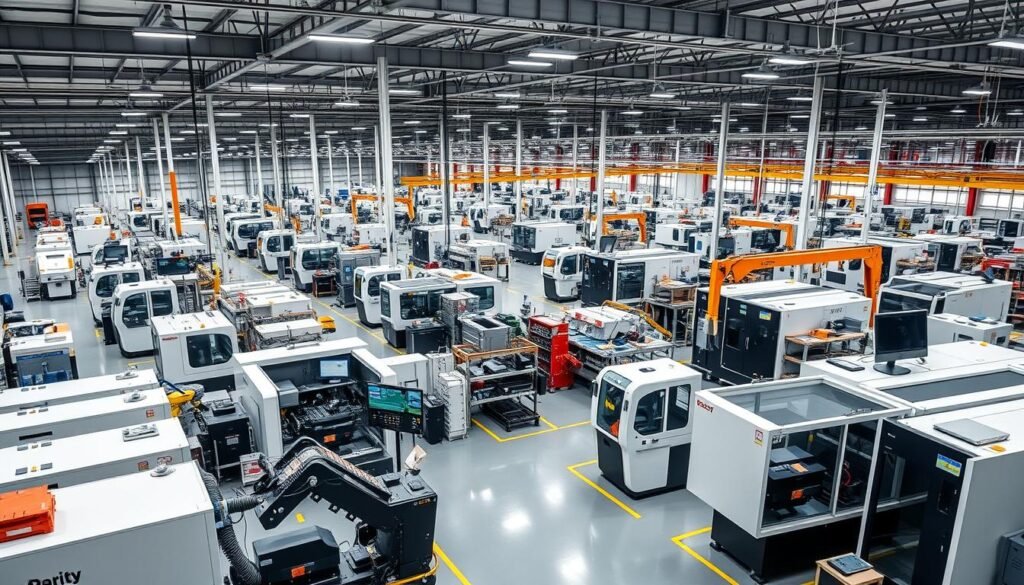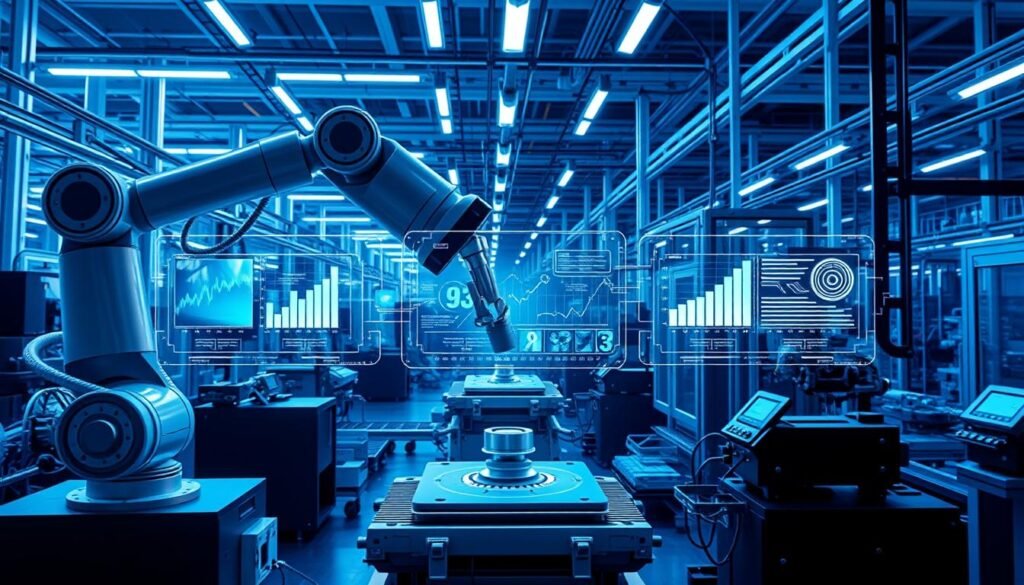The manufacturing industry is on the cusp of a revolution, driven by the adoption of new technologies that promise to boost efficiency, reduce costs, and enhance productivity. According to McKinsey, digital transformation can increase throughput by 10% to 30%, improve quality costs by 10% to 20%, and reduce machine downtime by up to 50%.
Despite these benefits, a PwC study found that only one-third of manufacturing companies have progressed beyond the initial stages of transformation. This comprehensive guide will explore how digital transformation is reshaping manufacturing processes, from production floors to supply chain management, and provide a strategic roadmap for implementation.
The impact of technology on business is undeniable. As companies adopt new technologies, they can make data-driven decisions, streamline operations, and gain competitive advantages.
Understanding Digital Transformation in Manufacturing Industry
The manufacturing industry is on the cusp of a revolution, driven by digital transformation. As technological advancements continue to accelerate, the need for manufacturers to adapt and evolve has become more pressing than ever.
Definition and Scope
Digital transformation in the manufacturing sector involves the integration of digital technologies into all areas of the business, fundamentally changing how companies operate and deliver value to customers. This transformation encompasses a wide range of technologies, including Industrial IoT, big data analytics, AI, and cloud computing.
The scope of digital transformation in manufacturing is broad, affecting everything from product design and production to supply chain management and customer service. By leveraging these digital technologies, manufacturers can create more efficient, agile, and responsive operations.
Why Digital Transformation Matters Now
The manufacturing industry is at a critical inflection point where digital transformation has moved from being optional to essential for survival and growth. Several factors are driving this shift:
- The manufacturing industry faces global disruptions, including the pandemic, supply chain challenges, and geopolitical tensions, which have accelerated the need for companies to become more agile and resilient.
- Customer expectations have evolved, demanding greater customization, transparency, and faster delivery times, putting pressure on traditional manufacturing models.
- The competitive landscape has intensified as digital-native companies enter the manufacturing space with innovative business models.
- Manufacturers must adopt digital technologies to enable more efficient resource utilization and environmental compliance due to sustainability requirements and regulatory pressures.
According to a PwC survey, the primary motivation for manufacturers investing in digital tools is now to become more resilient and flexible against business disruptions, rather than merely minimizing costs. As the market continues to evolve, companies that delay digital transformation risk falling behind competitors who are already leveraging these technologies to gain significant advantages in efficiency, quality, and market responsiveness.
The Current State of Digital Transformation in Manufacturing
The current state of digital transformation in manufacturing is characterized by both opportunities and challenges. As manufacturers navigate this complex landscape, they are discovering new ways to improve their operations and stay competitive in the market.
Adoption Rates and Challenges
Despite the potential benefits, the adoption of digital transformation in manufacturing is not uniform. According to PwC’s study, manufacturers who allocate 3% or more of their revenue to digital transformation are 2.5 times more likely to achieve higher returns on investment. However, on average, manufacturers invest only 1.8% of their net revenue in digital transformation, indicating a significant gap in effective budget utilization.
Some of the challenges manufacturers face include integrating new technologies with existing systems and addressing the shortage of skilled labor. Companies must strategically invest in digital transformation to overcome these hurdles and reap the benefits.
The Competitive Advantage Gap
A significant competitive advantage gap is emerging between digital leaders and laggards in the manufacturing industry. Early adopters are gaining substantial benefits, including improved operational efficiency, product quality, and market responsiveness. The gap is widening as digital leaders continue to build on their initial successes, creating a compounding effect that makes it increasingly difficult for laggards to catch up.
| Investment in Digital Transformation | Likelihood of Higher Returns |
|---|---|
| 3% or more of revenue | 2.5 times more likely |
| Average investment (1.8% of net revenue) | Lower returns on investment |
To remain competitive, manufacturers must accelerate their digital transformation efforts. For guidance on developing a winning strategy, visit Enterprise Al.
Key Technologies Driving Manufacturing Transformation
Several key technologies are revolutionizing the manufacturing landscape, enabling companies to achieve unprecedented levels of efficiency, productivity, and innovation. These technologies are not only transforming existing processes but also creating new opportunities for growth and competitiveness.
Industrial IoT and Smart Sensors
Industrial IoT and smart sensors are transforming manufacturing by providing real-time data on equipment performance, product quality, and operational efficiency. Industrial IoT manufacturing solutions enable predictive maintenance, reduce downtime, and optimize production processes.

Big Data and Advanced Analytics
The ability to collect and analyze vast amounts of data is crucial for making informed decisions in modern manufacturing. Manufacturing analytics platforms help companies gain insights into their operations, identify bottlenecks, and optimize production workflows.
AI and Machine Learning Applications
AI and machine learning are being increasingly adopted in manufacturing to improve process efficiency, product quality, and supply chain management. AI solutions for manufacturing enable predictive maintenance, quality control, and demand forecasting, among other applications.

Cloud-Based Manufacturing Solutions
Cloud-based manufacturing solutions offer numerous benefits, including scalability, flexibility, and cost-effectiveness. These solutions enable manufacturers to access enterprise-level capabilities without the need for extensive on-premises infrastructure. Cloud-based ERP and other manufacturing software provide tools for managing business operations, including inventory, production, and customer relationships.
- Cloud-based manufacturing solutions are enabling unprecedented flexibility, scalability, and accessibility for manufacturing operations of all sizes.
- These platforms provide manufacturers with enterprise-level capabilities without the need for extensive on-premises infrastructure, reducing capital expenditure and implementation time.
- Cloud manufacturing solutions facilitate real-time collaboration across different locations and departments, breaking down traditional silos in manufacturing organizations.
- The subscription-based model of cloud solutions allows manufacturers to scale their digital capabilities as needed and stay current with the latest technological advancements without major upgrade projects.
- Integration between cloud-based manufacturing execution systems (MES), enterprise resource planning (ERP), and supply chain management solutions creates a cohesive digital ecosystem.
- Remote monitoring and management capabilities enabled by cloud solutions have become particularly valuable for maintaining business continuity during disruptions and supporting hybrid work models.
- As cloud security continues to advance, manufacturers are increasingly comfortable moving mission-critical applications and sensitive operational data to cloud environments.
Top Benefits of Digital Transformation in Manufacturing Industry
The integration of digital technologies in manufacturing is yielding substantial benefits, transforming the industry’s landscape. As manufacturers adopt digital transformation, they experience significant improvements across various aspects of their operations.
Increased Operational Efficiency and Productivity
Digital transformation enhances operational efficiency and productivity in manufacturing by leveraging technologies like Industrial IoT and smart sensors. These advancements enable real-time monitoring and optimization of production processes, reducing downtime and increasing overall output. Automation and data analytics play a crucial role in achieving optimal takt time and enhancing shop floor visibility.
Cost Reduction and Resource Optimization
By implementing digital transformation, manufacturers can significantly reduce costs and optimize resources. Advanced analytics and AI enable better demand forecasting, allowing for more efficient inventory management and reduced waste. Digital platforms also facilitate better collaboration with suppliers, leading to more streamlined and cost-effective supply chains.
Enhanced Quality Control and Compliance
Digital transformation improves quality control and compliance in manufacturing by providing real-time tracking and tracing capabilities. This enables manufacturers to identify and address quality issues promptly, ensuring higher product quality and compliance with regulatory standards. Digital twins and advanced analytics further enhance quality control by allowing for predictive maintenance and simulation-based testing.
Improved Supply Chain Resilience and Flexibility
Digital transformation creates more resilient and flexible supply chains by providing end-to-end visibility and enabling faster response to disruptions. Key benefits include:
- Better demand forecasting and inventory optimization through advanced analytics and AI
- Closer collaboration with suppliers and customers through digital platforms
- Real-time tracking and tracing capabilities for improved logistics management
- Digital twins of supply chains for simulating different scenarios and developing contingency plans
According to the WEF, digital transformation improves OTIF scores by around 10 percentage points on average, which is crucial as OTIF penalties can cost medium-sized businesses around $350k.
| Benefits | Description | Impact |
|---|---|---|
| Increased Operational Efficiency | Leveraging Industrial IoT and smart sensors for real-time monitoring | Reduced downtime, increased output |
| Cost Reduction | Advanced analytics and AI for better demand forecasting | Efficient inventory management, reduced waste |
| Enhanced Quality Control | Real-time tracking and tracing, digital twins | Higher product quality, improved compliance |
| Supply Chain Resilience | End-to-end visibility, digital platforms for collaboration | Faster response to disruptions, improved OTIF scores |
Real-World Examples of Digital Transformation Success
The impact of digital transformation on manufacturing is evident in various success stories across the globe. Companies are leveraging digital technologies to enhance their operations, improve quality, and increase efficiency.
Case Study: Reducing Downtime with Predictive Maintenance
A leading manufacturer implemented predictive maintenance solutions to minimize equipment downtime. By analyzing data from sensors and machines, they were able to predict potential failures and schedule maintenance accordingly. This approach resulted in a significant reduction in downtime and an increase in overall production efficiency.
Case Study: Optimizing Production with AI Scheduling
Another manufacturer adopted AI-powered scheduling to optimize their production processes. The AI system analyzed various parameters, including machine availability and material supply, to create an optimized production schedule. This led to improved productivity and reduced delays, ultimately enhancing the manufacturing process.
Case Study: Enhancing Quality with Digital Twins
A Singapore-based manufacturer utilized digital twin technology to simulate and optimize their production processes. By creating a virtual replica of their factory, they were able to test different scenarios and identify the most efficient configurations. This resulted in a 25% reduction in production costs and improved product quality. For more information on how digital transformation can benefit your organization, visit enterprisal.com.
| Case Study | Technology Used | Outcome |
|---|---|---|
| Reducing Downtime | Predictive Maintenance | Significant reduction in downtime |
| Optimizing Production | AI Scheduling | Improved productivity and reduced delays |
| Enhancing Quality | Digital Twins | 25% reduction in production costs and improved quality |
These examples demonstrate the potential of digital transformation in manufacturing. By adopting innovative technologies and leveraging data-driven insights, manufacturers can achieve significant improvements in efficiency, quality, and overall competitiveness.
Implementing Digital Transformation: A Strategic Roadmap
The path to successful digital transformation in manufacturing begins with crafting a detailed strategic roadmap. This roadmap serves as a guide, outlining the necessary steps and milestones to achieve transformation goals.

Assessing Your Digital Maturity
Before embarking on a digital transformation journey, it’s crucial to assess your current digital maturity. This involves evaluating your organization’s current technological capabilities, identifying gaps, and understanding areas that require improvement or investment. According to Deloitte, understanding your digital maturity helps in creating a more focused transformation strategy.
Setting Clear Transformation Goals
Setting clear and measurable transformation goals is vital. These goals should align with your overall business strategy and could include objectives like improving operational efficiency, reducing costs, or enhancing product quality. By having well-defined goals, manufacturers can better measure the success of their digital transformation efforts.
Building a Cross-Functional Digital Team
Successful digital transformation requires assembling a cross-functional team that combines manufacturing expertise with digital technology skills. This team should include representatives from various departments such as operations, IT, and engineering. For instance, companies can benefit from creating dedicated digital transformation roles like a Chief Digital Officer to drive efforts. Moreover, partnering with technology vendors, as seen in ERP system implementations, can supplement internal capabilities.
| Key Roles | Responsibilities |
|---|---|
| Cross-Functional Team | Combining manufacturing expertise with digital technology skills |
| Chief Digital Officer | Driving and coordinating digital transformation efforts |
| Technology Vendors | Supplementing internal capabilities with specialized technologies or implementation expertise |
Overcoming Common Digital Transformation Challenges
The journey to digital transformation in manufacturing is fraught with challenges that require strategic planning and execution. As manufacturers implement more connected systems and digital technologies, they must address various obstacles to ensure successful transformation.
Addressing Skilled Labor Shortages
One of the significant challenges manufacturers face is the shortage of skilled labor. To overcome this, companies can invest in comprehensive training programs that upskill existing employees and attract new talent. By leveraging digital technologies, manufacturers can also optimize processes, reducing the dependency on manual labor. For instance, implementing automation and AI can help bridge the labor gap while enhancing productivity.
Managing Change and Cultural Resistance
Managing change effectively is crucial for the success of digital transformation. Manufacturers must address cultural resistance by fostering a culture of innovation and continuous improvement. This involves communicating the benefits of digital transformation clearly and involving employees in the change process. By doing so, organizations can build trust and encourage adoption of new technologies.
Ensuring Cybersecurity in Connected Environments
As manufacturing environments become increasingly connected, cybersecurity emerges as a critical concern. The convergence of IT and OT networks requires new governance models and security architectures. Manufacturers are adopting zero-trust security models to verify every user and device attempting to access resources. A comprehensive cybersecurity strategy includes security by design, regular vulnerability assessments, and employee security awareness training. This proactive approach helps mitigate risks associated with digital transformation.

| Challenge | Impact | Mitigation Strategy |
|---|---|---|
| Skilled Labor Shortages | Reduced productivity, increased costs | Training programs, automation, AI |
| Cultural Resistance | Slow adoption, decreased morale | Change management, employee engagement |
| Cybersecurity Risks | Data breaches, operational disruptions | Zero-trust models, security by design, vulnerability assessments |
Measuring Success: KPIs for Manufacturing Digital Transformation
The effectiveness of digital transformation in manufacturing can be gauged through a set of key performance indicators that cover various aspects of the business.
Operational Performance Metrics
Manufacturers are leveraging digital technologies to enhance operational efficiency. Key metrics include production cycle time, overall equipment effectiveness (OEE), and inventory turnover. These operational performance metrics help companies identify areas for improvement and measure the impact of their digital initiatives.
- Production cycle time reduction
- OEE improvement
- Inventory turnover rate
Financial Impact Indicators
Digital transformation also has a significant impact on a company’s financials. Manufacturers are tracking metrics such as return on assets (ROA), cost savings from process improvements, and revenue growth from new digital-enabled products. These financial impact indicators help companies understand the ROI of their digital investments.
- Return on Assets (ROA)
- Cost savings
- Revenue growth from digital products
Innovation and Sustainability Metrics
Beyond operational and financial metrics, leading manufacturers are measuring how digital transformation drives innovation and sustainability improvements. According to the World Economic Forum, digital transformation can reduce CO2 emissions and water consumption by approximately 15% on average.
- New product introduction cycle time
- Percentage of revenue from products less than three years old
- Carbon footprint reduction
- Resource efficiency metrics
By tracking these metrics, companies can ensure that their digital transformation efforts are yielding the desired outcomes in terms of innovation, sustainability, and overall business performance.
Future Trends in Manufacturing Digital Transformation
Emerging trends in digital transformation are set to redefine the manufacturing landscape, enhancing efficiency, productivity, and sustainability. As technology continues to evolve, manufacturers must stay ahead of the curve to remain competitive.
Sustainability-Driven Digitalization
The manufacturing industry is increasingly adopting sustainability-driven digitalization to reduce environmental impact. This involves leveraging digital technologies to optimize resource usage, minimize waste, and implement eco-friendly practices. By doing so, manufacturers can not only comply with environmental regulations but also improve their brand reputation and appeal to eco-conscious consumers.
Hyper-Personalization and Mass Customization
The trend towards hyper-personalization and mass customization is gaining momentum. Advanced technologies like AI and data analytics enable manufacturers to offer tailored products without compromising on efficiency or cost. This shift is driven by consumer demand for unique products and the ability of digital technologies to facilitate flexible production processes.
Autonomous and Lights-Out Manufacturing
The concept of autonomous and “lights-out” manufacturing is becoming a reality, with advancements in AI, robotics, and IoT. This trend involves the use of self-optimizing production systems, autonomous mobile robots, and AI-powered quality control systems. While fully autonomous factories are still rare, the implementation of “islands of automation” is becoming more common, transforming the workforce’s role towards supervision and continuous improvement.

Conclusion: Taking the First Steps Toward Digital Manufacturing Excellence
The path to digital manufacturing excellence requires a multifaceted approach, including technological, organizational, and cultural changes. Digital transformation in manufacturing is no longer optional but essential for companies seeking to remain competitive.
To achieve success, manufacturers must understand their current state, set clear goals aligned with their business strategy, and develop a roadmap that balances quick wins with long-term transformation. Starting with focused use cases and building a culture of continuous improvement are key.
By embracing digital transformation as an ongoing journey, manufacturers can achieve substantial improvements and competitive advantages, driving long-term success in the manufacturing sector.

